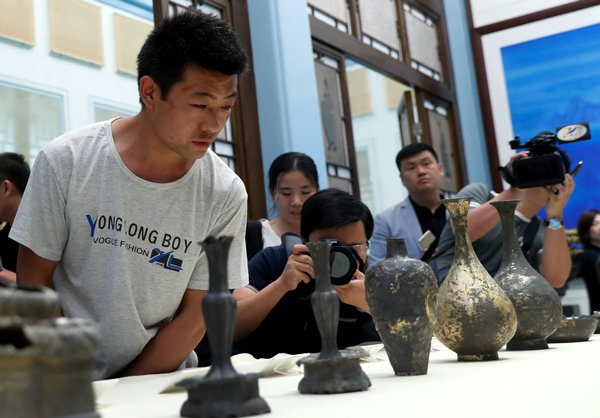Worker who gave priceless relics to museum praised
 |
|
He Junqing, whose father, He Gang, donated ancient relics to the Palace Museum in Beijing, takes a look on Thursday at some of the Yuan Dynasty (1271-1368) artifacts his father found while digging in his yard. [Photo/China News Service] |
The Palace Museum in Beijing held a memorial on Thursday for a villager who donated precious cultural relics to the museum.
He Gang, a villager from Shangshui county, Henan province, discovered 19 silver artifacts from the Yuan Dynasty (1271-1368) in a buried jar he found while digging in his yard in 1985. The items are mainly vases and other containers believed to have been for daily use.
After turning down what villagers later described as a large bag of cash from antique dealers, He insisted on giving the artifacts to the country, officials said. He and two other villagers took a train to Beijing to give them to the Palace Museum.
He was killed in an accident on May 30 when a crane collapsed as he was helping to build a high-speed train track in Shandong province. He was 54.
Such a memorial, dedicated to an ordinary person rather than a renowned scholar, is rare in the history of the Palace Museum, the former imperial complex known as the Forbidden City. The museum houses 1.86 million artifacts.
The 19 items found by He filled a void in the huge collection, said Lyu Chenglong, a researcher at the museum.
"Many items housed in the museum are former royal collections from the Ming (1368-1644) and Qing (1644-1911) dynasties, but Yuan articles are relatively rarely seen, let alone such delicate silver articles," Lyu said.
"Patterns and designs of the world-famous blue and white Yuan porcelain were developed from silver articles of that dynasty. The items donated by He greatly helped our research."
It is extremely rare to find such relics, which had remained intact in an ancient cellar, thereby preserving crucial historical information, said Li Ji, an archaeologist at the museum.
Some of the items donated by He have been periodically displayed, but are not on permanent display, officials said.
Shan Jixiang, director of the Palace Museum, praised He. "What He reflects is awareness of protecting traditional cultures and sticking to a righteous course," Shan said. "During a time when some people were driven by economic motives and robbed cultural relics, such a spirit should be highly respected."
More than 34,000 artifacts in the museum have been donated by about 700 people, but most were tycoons or scholars, Shan said. The museum has a special exhibition hall where their names, including He's, are displayed on plaques.
In 1985, the Palace Museum allocated about 9,000 yuan (about $3,000 at the time) as a reward for He and two other villagers who carried the artifacts to Beijing. When He encountered some job difficulties in later years, the museum also donated some money for his support. With his death, the museum donated 100,000 yuan ($14,600) to his family.
While this made some question his "donor" status, Gu Yucai, deputy director of the State Administration of Cultural Heritage, noted: "Public support is essential to preserving cultural relics. Donors deserve some bonus for their good deeds to set an example for others."
Gu said a national system to standardize such bonuses would help to create better conditions for donations of cultural relics.









